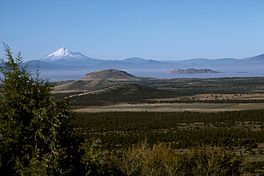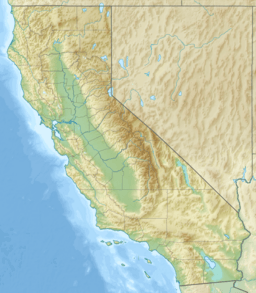Tule Lake facts for kids
Quick facts for kids Tule Lake |
|
|---|---|

Overview of the Tule Lake Basin
|
|
| Location | Siskiyou / Modoc Counties, California, United States |
| Coordinates | 41°54′34″N 121°31′59″W / 41.90932°N 121.53305°W |
| Type | Ancient lake, Intermittent lake |
| Primary inflows | Lost River |
| Max. length | 8.0 km (5.0 mi) |
| Max. width | 4.8 km (3.0 mi) |
| Surface area | 13,000 acres (5,300 ha) |
| Surface elevation | 4,035 ft (1,230 m) |
Tule Lake (pronounced TOO-lee) is a special kind of lake in northern California, right near the border with Oregon. It's about 8 kilometers (5 miles) long and 4.8 kilometers (3 miles) wide. This lake covers an area of about 13,000 acres. Tule Lake is known as an intermittent lake, which means its size can change a lot depending on the season and how much water flows into it.
Contents
About Tule Lake's Location
Tule Lake is fed by the Lost River. The lake sits at an elevation of about 4,035 feet (1,230 meters) above sea level.
An Ancient Body of Water
Tule Lake is one of only about twenty ancient lakes in the world. This means it has existed continuously for more than a million years. Imagine how much history this lake has seen!
Where to Find Tule Lake
You can find Tule Lake about 2.4 kilometers (1.5 miles) southwest of the town of Tulelake. This area is in Northern California.
Wildlife and Water at Tule Lake
Tule Lake is a very important place for animals. It is part of the Tule Lake National Wildlife Refuge. This refuge is a protected area where many birds and other creatures live.
Helping Wildlife Thrive
The lake also gets water from the Klamath Project. This project helps manage water for farms and wildlife in the area. Water deliveries from the Klamath Project are very important for the animals living around Tule Lake. For example, in July 2020, a special water delivery saved 50,000 ducklings. This shows how vital these water efforts are for the lake's wildlife.
History Around Tule Lake
The area around Tule Lake has a rich and sometimes difficult history.
Canby's Cross Site
About 3 miles (4.8 kilometers) south of the lake, you can find Canby's Cross. This spot marks where General Edward Canby was killed. He was killed by a leader of the Modoc tribe named Kintpuash, also known as Captain Jack. This event happened during a conflict between the Modoc people and the United States Army.
Tule Lake During World War II
During World War II, something very unfair happened in the United States. The government made a rule called Executive Order 9066. This rule forced many Japanese people and Japanese Americans to leave their homes. They were sent to special camps far away from the coast. Many of these people were American citizens, born in the U.S. They had to sell their businesses and homes quickly, often losing a lot of money. They also faced great emotional hardship because they were treated as potential enemies.
One of these camps was the Tule Lake War Relocation Center. It was located east of Tule Lake. After the war ended, the government offered land near Tule Lake to soldiers who had returned from the war. This land had been made usable by draining parts of the lake. There were more soldiers who wanted land than there were spots available, so they used a lottery system to decide who would get a farm.



